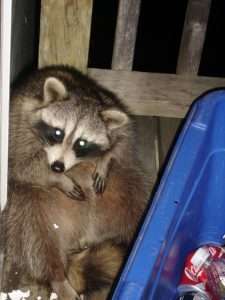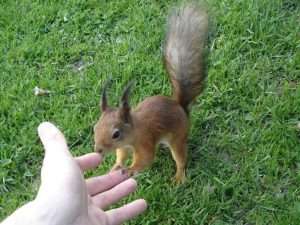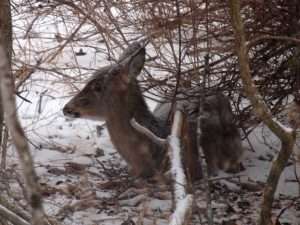 Winter is here in the Northern Hemisphere, which means that wild animals of all sorts are falling back on cold weather adaptations that have evolved over countless generations. Some, like reptiles and amphibians, go into brumation or other hibernation-like states. Others have warm feathers or fur to insulate them as they go about their lives in chilly conditions. They may migrate around their territory in search of various food sources. Not all will survive these harsh months, which makes feeding wildlife to help them through the hard times a tempting idea.
Winter is here in the Northern Hemisphere, which means that wild animals of all sorts are falling back on cold weather adaptations that have evolved over countless generations. Some, like reptiles and amphibians, go into brumation or other hibernation-like states. Others have warm feathers or fur to insulate them as they go about their lives in chilly conditions. They may migrate around their territory in search of various food sources. Not all will survive these harsh months, which makes feeding wildlife to help them through the hard times a tempting idea.
Unfortunately, while this is a kind-hearted act born of good intentions, the impact is all too often harmful. Here are a few of the damaging, even deadly, effects of feeding wildlife.
Mammals vs. Birds
First, let’s be a little more nuanced about the definition of wildlife in this case. I support the feeding of birds, at least those that commonly visit bird feeders. These birds are of species that are used to their food sources–like seeds, berries, and insects–being temporary, and so they retain their ability to forage for food in various places. Also, because the birds are not being fed by hand, and tend to retain their natural fear of humans, they are not likely to become habituated to us. It should go without saying that trying to convince birds to eat from your hand, or otherwise stop being afraid of you, is a bad idea (more about that in a minute.) And, of course, you need to make sure to keep your feeders clean and watch your local birds very carefully for any signs of disease; here’s an article I wrote on feeding birds safely and ethically.
Wild mammals, on the other hand, have a tendency to become dependent on human sources of food much more readily than birds. If you leave food scraps, pet food, or trash out where they can access it, they quickly figure out that this is an easy meal, and will hang around more than birds might.
Some birds will be more easily habituated than others; ducks and geese, for example, will lose their fear of humans as quickly as mammals do, especially when being fed regularly at ponds or lakes. So consider this article to primarily cover wild mammals, waterfowl, and any other animal that can be easily habituated through feeding.
Feeding Wildlife Causes Behavior Changes

Habituation is the biggest behavior change seen in fed wildlife. A habituated animal is simply one that no longer fears humans, and sees us as a source of food handouts. Unlike normal, healthy wildlife, these animals do not run away when a human approaches, even at a close distance. As mentioned above, this means they may even become aggressive in seeking food, and people have been bitten, scratched, gored, or otherwise injured by habituated animals. It may be easy to see why a habituated bear or moose is dangerous, but even smaller animals like squirrels or raccoons have a very nasty, painful bite or scratch. Some also carry zoonotic diseases that can be passed to humans; rabies is the most notorious, but even a bacterial infection caused by the bite or scratch can be an unpleasant experience.
But this lack of fear isn’t just a threat to us. It also puts the wildlife at risk. Wild mammals that wander through our neighborhoods in search of food are more likely to be hit by cars, attacked by outdoor dogs or cats, and injured or killed by cruel humans. If hunting is allowed in the area, the animal may walk right up to a hunter. Plus wild animals that become a nuisance or threat to people are sometimes euthanized, as relocated animals often end up finding their way back to their original territory, or go find a new group of humans to mooch off of.
Feeding wildlife can also cause them to cease natural foraging behaviors. Not only does this mean they may starve if the humans in the area stop feeding them, but they don’t teach their young proper foraging either, and so you may have animals several generations down the line that no longer know how to find natural food sources in the area.
What We’re Feeding Wildlife Can Kill Them
So here’s the thing: humans are omnivores. Actually, we’re sort of super omnivores; we have one of the most varied diets of any species, especially now that we’re able to grow all sorts of domesticated crops, including but not limited to two dozen cultivars of wild mustard (Brassica oleracea), various and sundry grains, legumes, tubers, etc. And because we’ve spread all throughout the planet, we’ve successfully sampled thousands upon thousands of edible animals, plants, and fungi. We’ve managed to evolve tolerances to substances some plants produce to keep from being eaten, like caffeine and capsaicin, and some of us go out of our way to seek them. We’ve also heavily altered some of our foods through cooking, to include some methods that render the food quite unhealthy even for us (not that that stops us from eating it anyway.)
All of this means that over 300,00 years of existence, Homo sapiens has evolved the ability to eat a truly mind-boggling array of foods. Unfortunately, even the other omnivores in our lives can’t necessarily tolerate the foods we eat. Domestic dogs evolved alongside us, eating first our refuse, and then sharing our meals, for thousands of years. Yet they still can’t safely eat chocolate, avocado, onions, or grapes, and some things we’ve created like the artificial sweetener xylitol can also be harmful–even deadly–to dogs.
So when you put out a plate of table scraps for your local squirrels, opossums, raccoons, or even bears, there’s a very good chance that something there is going to make them sick. You could even be sentencing one of your visitors to death! Even if they don’t immediately get sick, over time eating the wrong foods could seriously affect the health of wildlife, and may lead to sickness and an earlier, unpleasant death.
 Sometimes, even something that seems like the “right” food can be deadly. Deer species in North America are adapted to eating lots of woody vegetation in winter; their gut microbiome is perfectly balanced to digest this tough food. However, some people like to feed them corn, either because they want to be nice, or because they want to hunt the deer. Unfortunately, the nutritional makeup of corn is very different from the deer’s winter fare. The carbohydrates in the corn can cause a condition called rumen acidosis. This overloading of carbs causes Streptococcus bacteria, which occur naturally in the deer’s chambered stomach, to overpopulate in a matter of hours. This raises the acidity of the stomach, and kills off many of the other microbes in the gut flora. This sudden imbalance essentially causes the stomach to stop digestion altogether. In a severe enough case, the deer dies a horribly painful death within twenty-four hours. Deer that survive often have permanently damaged stomachs, which can lead to worse health overall and a shortened lifespan.
Sometimes, even something that seems like the “right” food can be deadly. Deer species in North America are adapted to eating lots of woody vegetation in winter; their gut microbiome is perfectly balanced to digest this tough food. However, some people like to feed them corn, either because they want to be nice, or because they want to hunt the deer. Unfortunately, the nutritional makeup of corn is very different from the deer’s winter fare. The carbohydrates in the corn can cause a condition called rumen acidosis. This overloading of carbs causes Streptococcus bacteria, which occur naturally in the deer’s chambered stomach, to overpopulate in a matter of hours. This raises the acidity of the stomach, and kills off many of the other microbes in the gut flora. This sudden imbalance essentially causes the stomach to stop digestion altogether. In a severe enough case, the deer dies a horribly painful death within twenty-four hours. Deer that survive often have permanently damaged stomachs, which can lead to worse health overall and a shortened lifespan.
Feeding Wildlife Leads to Ecological Imbalances
Every ecosystem has adapted over thousands of years; in some cases, an ecosystem may be millions of years old (with some changes in species makeup, of course.) Over that time, species have evolved to keep each other’s numbers in check, whether through consuming each other, competing for resources, or spreading disease to other species as well as their own. One of the biggest limiting factors in a species’ habitat is the amount of food that’s available. You’ll generally have fewer large predators in a place than large herbivores, for example, because the land can support a lot more plants to feed herbivores than herbivores to feed carnivores.
So the ecosystem is able to keep its species in balance; any time a species begins to overpopulate, predation, starvation and disease tend to knock the numbers back. Some species even have “boom or bust” population cycles; lemmings, for example, are thought to have population fluctuations tied to the number of ermine preying on them in a given area.
But when we humans artificially change the availability of food in a given place, we can cause serious disruptions in these natural checks and balances. Put too much food in a place over time, and you end up with overpopulations of the animals that eat that food, with subsequent deaths from disease due to overcrowding, and starvation when the population inevitably outgrows even the artificially added food.

Speaking of disease, when feeding wildlife many people just dump the food in the same place every day or night, whether that’s pet bowls, a trash can, or a feeding site. This causes wildlife to congregate in unnaturally large numbers and on a regular basis, which again leads to increased disease transmission. Keep in mind that wildlife don’t have veterinarians they can just go to when sick, so you end up with wild animals dying some pretty slow, awful deaths due to these diseases. (And yes, this can happen with birds–again, why it is so incredibly important to properly clean your feeders regularly!)
Keep Wildlife Wild
I know it’s tempting to entice wildlife closer, and to want to help them through tough times. But it is incredibly important to keep a firm boundary between us and wild animals. We’ve already interfered in their lives and their behaviors enough. The more we meddle, the more harm we do to them, even if our intentions were good.
But wildlife are not pets. They are their own beings with their own lives and agendas, instincts and territories. They are, as Henry Beston wrote in The Outermost House, “not brethren, they are not underlings: they are other nations, caught with ourselves in the net of life and time, fellow prisoners of the splendour and travail of the earth.” And we respect them best when we give them their space and allow them to live as wild a life as possible in a world we have so dramatically changed.
If you want to create the best world for your local wildlife, create habitat and natural food sources for them. Remove invasive species, and plant more native plants, especially those that offer food and shelter to wildlife. (The native plant finder is a great starting point for those in the US.) Work to protect what wildlife habitat is left, especially habitats that are relatively undamaged like old-growth forests. This way you are helping to maintain space where these species can live the lives they have lived for many thousands of years without our interference.
